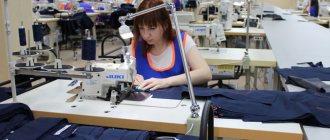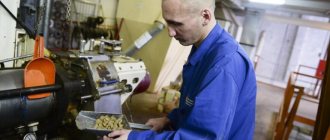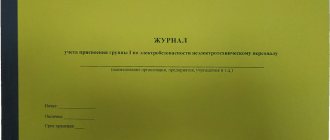Occupational safety is a primary requirement
When organizing a workplace, it is important to observe several basic criteria:
- safety;
- comfort;
- environmental component;
- preventing the risk of occupational diseases;
- suppression of the possibility of an accident at work.
Workplace
This entire list relates to the concept of labor protection at the enterprise.
Deadlines
Scheduled inspections of compliance with labor protection requirements are carried out at least once every five years. The first is carried out no later than two months after the opening of the company.
The assessment may be carried out more frequently at the discretion of the administration. For example, if the situation has improved and management wants to contribute less to the funds, reduce the cost of protective equipment and compensation.
The final report is studied by inspectors for ten days. Signed protocols are attached to it. The completed documents are transferred to the director, who issues an order to complete the procedure and familiarizes the staff with the results.
After receiving the report, a final statement is compiled in electronic and paper versions and sent to the local inspectorate. This documentation is stored for 75 years if harmful factors occur at the enterprise, and 45 years if there are none.
Organization of the workplace: occupational safety requirements
Requirements for the workplace are described in the Labor Code of the Russian Federation, SanPiN and local regulatory documents of the organization. Their compliance is monitored by a labor protection engineer.
Lighting standards for an office workplace
With a well-planned workspace, an employee will be able to show the best results and achieve their goals and objectives within the established time frame. In this case, the workplace must meet a number of parameters.
Noise and vibration levels in the working area
The maximum permissible threshold for noise level in the workplace is within 80 dB. To reduce noise and vibration emitted during operation, special sound-absorbing surfaces and shock-absorbing pads are used for the equipment that is the source of noise.
Substrates and foundations are also used to reduce vibrations.
Important! For certain professions, the level of noise and vibration is calculated individually. For example, for a train driver, excavator driver, boiler and pump house worker, the maximum permissible values are higher, but representatives of professions are entitled to an additional payment for this.
Indoor microclimate
An optimal microclimate must be maintained in the working area of each worker. If the work is predominantly sedentary and does not require significant physical exertion, then the recommended temperature in winter should not fall below 22-24 degrees. In summer, the optimal temperature ranges from 23-25 degrees. The air humidity in the room should not fall below 40%, but should not exceed 60%. If humidity is insufficient, the employer must provide air humidifiers.
Air speed – 0.1 m/s.
If the employer is unable to provide the specified conditions, then the duration of the working day should be reduced, and sometimes the work process may be completely suspended in accordance with Sanitary Rules and Norms 2.2.4.3359-16 dated June 21, 2016 No. 81.
What is the cost of workplace certification?
The cost of SOUT consists of a large number of components. Initially, the organization authorized to conduct certification assesses the upcoming scope of work based on information provided by the employer. During an external inspection of workplaces, experienced specialists immediately identify those where there are no dangerous factors for health and life, therefore, the procedure for them will be assessed at the minimum rate.
For those workplaces where, during an external inspection, the risk of harmful factors was determined, tariffing is carried out after additional study. The cost of work is also affected by the availability of similar types of jobs - for them, regardless of the labor intensity of the procedure, experts will receive a large discount on the cost.
The employer's task is to competently compile a list of workplaces to be assessed and identify similar zones, which will lead to large savings. In general, the cost of certification is determined according to the following criteria:
- scope of work to be done
- number of jobs, their complexity and specificity
- number of similar plots
- complexity of the production process and associated environmental factors
- localization is an important aspect for network companies, which is associated with additional transportation costs, since experts will have to move from one branch or representative office to another to carry out a range of work
- carrying out laboratory research and measurements
- preparation of documentation (the availability of documents from previous certification will significantly simplify the process and, therefore, lead to cost reduction)
- existing special requirements for certification for a specific enterprise
As a result, the cost of SOUT can vary from 1.4 to 3.0 thousand rubles. for one workplace. The complexity of the process causes significant costs.
Top
Write your question in the form below
Requirements for premises for working with PCs
Requirements for a workplace in office premises
In a room in which workstations equipped with computer equipment are supposed to be located, a number of conditions must be observed. This will create the most comfortable conditions for workers:
- the distance between monitors is at least 2 meters;
- work desks are arranged in such a way that sources of natural light are located predominantly on the left. In this case, the displays must be oriented with their side surface;
- It is recommended that operators’ jobs be separated from each other if workers are engaged in heavy mental or creative work. Partition height 1.5-2 m;
PC worker
- The screen is positioned clearly at eye level. At the same time, it is recommended to equip some workplaces with special stands for monitors. The distance from the monitor to the worker’s eyes should be within 60-70 cm, but in no case less than 50 cm;
- the keyboard is located on the work surface 10-30 cm from the edge of the table;
- if the work of a computer user involves simultaneous work with reading, then special stands are provided for convenience;
- The work chair is swivel, adjustable in height and backrest tilt. The surface of the chair is semi-soft, with non-slip textiles and non-electric. It should be breathable and easy to clean;
- In some cases, workers may need a footrest.
Protection from negative effects of PC
Many employees use PCs while performing their job duties. In this regard, special standards have been developed that should be taken into account when working with computer equipment. The requirements for an office workplace are as follows:
- sanitary requirements for the organization of the workplace indicate that when working with a PC with a flat-panel monitor, the work area must have an area of at least 4.5 m². In case of using a kinescope monitor - 6 m²;
- the room must be ventilated every hour;
- sanitary requirements for a workplace located in the basement state that the use of copiers, printers and other office equipment is unacceptable (SanPiN 2.2.2.1332-03).
Also, SanPiN 2.2.2/2.4.1340-03 dated 05/30/2003 (as amended) informs about what requirements the design of the workplace must meet, what the height and width of the worktable should be, and the presence of a special footrest.
Regulatory acts regulate the level of electrostatic and electromagnetic fields, as well as radiation, ultraviolet radiation, radio frequency ranges, etc. That is, all those factors that do not have the best effect on the health of workers.
Cleaner's area
Labor protection instructions for auxiliary workers
Cleaners are personnel without a strictly defined workplace. During the entire shift, they move quite actively around the given space. This type of work refers to a non-stationary workplace.
Inventory storage room
The work involves close contact with household and professional chemicals, which cannot but affect health. Therefore, these personnel must be equipped with PPE, namely gloves, an apron or overalls. When assessing working conditions, the commission pays attention to the degree of exposure to chemicals in a given work area (in an office, medical facility, warehouse). The volume of area allocated for storing equipment must be at least 2 m2.
Goals and criteria for certification
The purpose of such a thorough inspection is to identify conditions that are life-threatening or harmful to the health of workers. The inspection commission is guided by the provisions of Article 209 of the Labor Code, which contains all the basic state requirements for labor protection. The employer is obliged to carry out measures established by the state to bring working conditions into compliance with accepted standards.
According to the sixth part of Article 209 of the Labor Code, a place to work means a specially equipped place where an employee stays for the entire shift or day, and at the same time his activities are controlled by employers.
Ministerial order number 590Н, issued in December 2012, amended the previously valid order number 342Н.
Currently, do not require certification :
- office-type places where workers are not directly involved in the production process and special equipment;
- places where employees work exclusively with household or copying (office) equipment.
At the same time, the list of places that require thorough and regular inspection (at least once every five years) is quite extensive.
These include:
workplaces related to the storage, use (application) or transportation of various substances and materials;- places where the use of various tools (electrical, mechanical or manual) is required;
- places with potential sources of danger to humans (for example, the presence of high-voltage electrical cables, electromagnetic radiation, vibrations, and so on);
- places where various equipment is used, repaired, debugged or tested (transport, mechanisms, machines, installations, devices and other technical devices);
- places where workers are busy working on various technical equipment, machines, vehicles, installations and apparatus.
Sanitary and hygienic requirements for the workplace
Maintaining an optimal indoor microclimate is regulated in SanPiN 2.2.4.548-96. This regulatory document describes the requirements for the need to maintain optimal temperature and relative humidity, as well as the need to maintain a ventilation system that ensures a balance of fresh air inflow and outflow. At the same time, it is important to observe the noise level of the fans and regularly refuel the air conditioners.
Important! Lighting recommendations are described for individual workplaces.
Space for picker
To ensure a normal work process, the picker's workplace must be equipped, first of all, with the necessary equipment and mechanisms. If you are working with large-sized goods, then the employee moves on a truck, and the workplace is the entire area of the warehouse.
When weighing products is included in his job duties, he is provided with scales.
The position of a picker requires the presence of additional artificial lighting sources to ensure safety throughout the entire work process.
Picker at work
Space for cashier-controller
Since the work of a cashier-controller involves a mostly sedentary position, it is important to provide employees with a comfortable chair.
Criteria:
- with a lifting and turning mechanism;
- seat height – 40-45 cm, with the possibility of individual adjustment;
- width – 42 cm;
- depth – 41 cm;
- the backrest is slightly curved to support the back.
The surface of the chair has low thermal conductivity, and the fabric allows for wet cleaning.
Additionally, employees are given footrests with the ability to adjust the angle of inclination.
The next important factor is to ensure good lighting. To protect against criminals, emergency call buttons are installed, and in some cases, protective glass is installed.
Cashier controller
Workplace lighting requirements
Office spaces for workers should be illuminated in the range of 300 to 500 lux. Some positions require individual lighting. It is better to install lamps above the work area to avoid glare.
Important! Additional lighting sources must be installed in such a way that they do not glare. It is especially important to adhere to the rules for representatives of professions that require precision actions - welder, repairman, electrician, etc.
Organization of the secretary's workplace
The secretary is the first assistant to the director of the organization. Its place should not only represent the well-being of the company, but also be as functional as possible. The reception area is divided into 2 zones: a working area and a waiting area for visitors.
Secretary's workplace
The list of necessary things for a secretary's workplace includes:
- table and chair;
- cabinet or rack for documentation;
- additional (auxiliary) table.
The furniture is arranged in such a way that the worker can quickly get from one corner of the room to another.
Next, you need to take care of the availability of a telephone, computer, copy machine, printer and other office equipment, depending on the type of activity of the company.
Important! The secretary's workplace should be located in such a way that the visitor can immediately see him and ask questions. It is important that the secretary can notice the client from afar.
Regulations on the Labor Safety Commission
A commission is formed in accordance with the regulations adopted at the enterprise. This document is the main one in regulating the work of this body. The regulations are drawn up through the submission of proposals and the participation of all parties. It is put into effect by the approval of the company management.
How to prepare and approve the position?
The preparation of the regulations takes place during a general meeting of the company’s employees with the involvement of the work collective itself, the administration of the organization and, if available, representatives of the trade union cell in the discussion. Based on the agreement, the document is drawn up and approved.
The regulations on the creation of the commission must stipulate:
- composition of the commission;
- the number of its members;
- the period for assigning the relevant powers.
Providing conditions for eating
The procedure for eating at the workplace is regulated by Article 108 of the Labor Code of the Russian Federation. Organizing a space for eating is a right, but not an obligation, of the employer. However, there are cases from judicial practice in which the rights of workers were recognized as infringed. Such cases include a ban on eating in the workplace, while the enterprise itself is removed from public catering areas. In this regard, recommendations SNiP 2.09.04-87 on the organization of premises have been developed:
- if the organization employs less than 10 people, a common space of more than 6 m2 with a table is required;
- for a number of employees up to 29 people, the recommended room area is 12 m2;
- if less than 200 people are employed, the organization of a canteen and distribution center is mandatory;
- if the quantity is more than 200, the canteen is required to be supplied with food.
The dining room
In a dedicated room there are tables and chairs, microwaves, kettles and other cooking appliances. It is also recommended to consider a sink for washing dishes and hands.








